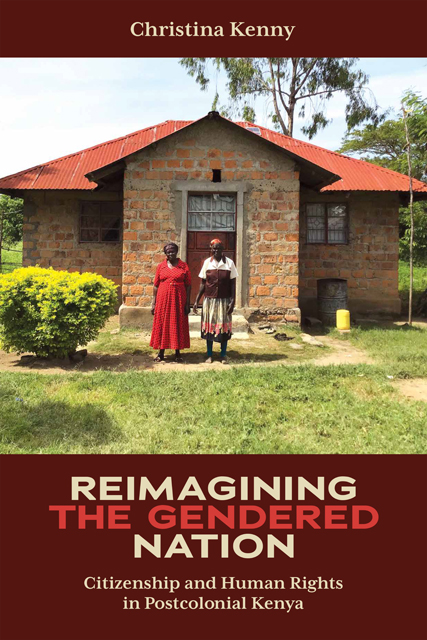Book contents
- Frontmatter
- Dedication
- Contents
- List of Illustrations
- Acknowledgements
- Note on Ethnic Identities
- List of Abbreviations
- Introduction
- 1 The Kenya Colony in British East Africa: A History of Ethno-patriarchy
- 2 Bodies as Battlefields, Bodies as Weapons: The Colonial Regulation of Women’s Bodies
- 3 Myths of Sorority: Kenyan Women’s Community Organisation
- 4 Everyday Violence: Violence against Women during Elections and Times of Peace
- 5 Gendered Citizenship, Politics and Public Space: Women’s Participation in Government
- Conclusion
- Appendix: Field Work, Focus Groups and Interviews
- Bibliography
- Index
- Eastern Africa Series
1 - The Kenya Colony in British East Africa: A History of Ethno-patriarchy
Published online by Cambridge University Press: 17 December 2022
- Frontmatter
- Dedication
- Contents
- List of Illustrations
- Acknowledgements
- Note on Ethnic Identities
- List of Abbreviations
- Introduction
- 1 The Kenya Colony in British East Africa: A History of Ethno-patriarchy
- 2 Bodies as Battlefields, Bodies as Weapons: The Colonial Regulation of Women’s Bodies
- 3 Myths of Sorority: Kenyan Women’s Community Organisation
- 4 Everyday Violence: Violence against Women during Elections and Times of Peace
- 5 Gendered Citizenship, Politics and Public Space: Women’s Participation in Government
- Conclusion
- Appendix: Field Work, Focus Groups and Interviews
- Bibliography
- Index
- Eastern Africa Series
Summary
‘The transformation of Kenya from a polyglot of strangers into a coherent state was the work of force.’
The histories of the peoples of East Africa and, latterly, those who were geographically contained within the territory that is now the Republic of Kenya, extend centuries before the Portuguese built the critical trading port of Fort Jesus in Mombasa in 1593. Indeed, ancient Greek documents date trade from Greece and Rome with Lamu and Zanzibar islands as early as AD 100. Despite the length and complexity of this precolonial history, it is the short but cataclysmic period from contact with British trading interests in the 1880s to independence in December 1963 that continues to significantly influence Kenya’s modern identity. It is this period that will be examined here, so that the beginnings of the gendered nation can be understood in their historical context, and we can trace the legacies of that history through the postcolonial period.
Motivated by a combination of tantalising trading opportunities and increasing missionary interest in ‘civilising’ the East African coast, the British established a presence in parts of East Africa in the 1880s. The Imperial British East Africa Association (IBEAA) began its economic exploration of the territories of East Africa in 1884, although it initially failed to secure backing from the British government. The IBEAA was reformed as the Imperial British East Africa Company (IBEAC) and was granted a royal charter in 1888, at least partly in response to the increasing German domination of the East African coast. Although the IBEAC was in control of Kenya and Uganda, the Company quickly realised that it could not meet its administrative costs. Nor was it able to pursue its goals of eradicating the slave trade in East Africa, opening the territory to a laissez-faire economic system and taking advantage of the economic opportunities for trade that were thought to exist in the interior. Persuaded to keep the territories out of the hands of the Imperial German Government, the Foreign Office took over responsibility for Uganda in 1893 and East Africa in 1895, renaming it the British East Africa Protectorate. By an Order in Council dated 11 June 1920, the East Africa Protectorate was annexed to the British Dominions under the name of the Colony of Kenya.
- Type
- Chapter
- Information
- Reimagining the Gendered NationCitizenship and Human Rights in Postcolonial Kenya, pp. 20 - 39Publisher: Boydell & BrewerPrint publication year: 2022

